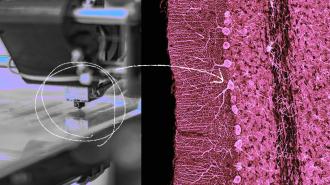Scientists at the University of Wisconsin–Madison (UWM) say they have created the first 3D-printed brain organoids that function like natural brain tissue.
“The neurons communicate, send signals, interact with each other through neurotransmitters, and even form proper networks with support cells that were added to the printed tissue,” said senior author Su-Chun Zhang.
The challenge: In the right conditions, stem cells will self-assemble into tiny, three-dimensional tissues that mimic features of the human brain. These “brain organoids” can be used to test drugs, study diseases, and more.
Because brain organoids self-assemble, researchers don’t have much control over their final structure, and their mini brains might not grow into the best design for their research.
“They were still able to talk to each other in a very special and specific way.”
Su-Chun Zhang
Some scientists have tried using 3D bioprinting to gain more control over the location and types of brain cells in an organoid, but getting these soft, cell-filled “inks” to stay in place is a challenge, and using stiffer substances or scaffolding prevents the cells from forming natural connections with one another.
3D-printed brain organoids: The UWM team took a different approach for its study, which has been published in the journal Cell Stem Cell.
First they coaxed stem cells to start developing into different types of brain cells. These different cells were mixed with a hydrogel to create a printable “bioink.”
Instead of stacking layers vertically — the traditional 3D printing approach — the UWM team went horizontally, placing strips of the bioink next to one another. This meant their 3D-printed brain organoids were just 50 micrometers “tall,” but that thinness ensured the neurons got the oxygen they needed.
“This could be a hugely powerful model.”
Su-Chun Zhang
As hoped, this approach also led to the formation of natural connections between the cells in the mini brains — different cell types in different layers could send signals to one another, and they formed networks similar to those seen in natural brain tissue.
“The tissue still has enough structure to hold together but it is soft enough to allow the neurons to grow into each other and start talking to each other … Even when we printed different cells belonging to different parts of the brain, they were still able to talk to each other in a very special and specific way,” said Zhang.
Looking ahead: The researchers plan to continue refining their technique, looking for ways to get even more control over the orientation of the cells in their 3D-printed brain organoids, perhaps by making changes to their bioink.
They’re hopeful other labs might adopt their technique for their own research, given that it doesn’t require any special equipment — they used a commercial bioprinter and standard imaging tech for their study.
“This could be a hugely powerful model to help us understand how brain cells and parts of the brain communicate in humans,” says Zhang. “It could change the way we look at stem cell biology, neuroscience, and the pathogenesis of many neurological and psychiatric disorders.”
We’d love to hear from you! If you have a comment about this article or if you have a tip for a future Freethink story, please email us at [email protected].





